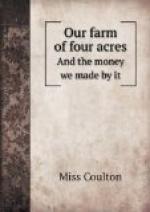An acre of grass is usually considered sufficient to support a cow during the year. If that had to be rented apart from the house, the average price would be about $25. Supposing we place that value on our land, the accounts for six months would stand thus:
EXPENSES. Land at $25 the acre, for half a year, . . . . . . . . . $25 00 Oil-cake, . . . . . . . . . . . . . . . . . . . . . . . 4 50 Half the expense of getting the hay, . . . . . . . . . . 7 50 $37 00 PRODUCE. Value of milk and butter, . . . . . . . . . . . . . . . . $116 50 Leaving a balance in our favor, at the end of six months of $79 50.
At the commencement of the winter, a cow-keeper in the neighborhood told our man that we should give our cows a little mangel-wurzel. We inquired, Why? and were told that we should “keep our cows better together;” so we paid a guinea for a ton of that vegetable. The first time we made butter after they had been fed with it, we found it had a very strong, bitter taste. Still, we did not condemn the mangel-wurzel, but tried it another week. The butter was again bad, so we abandoned the roots, and resolved to give the animals nothing but hay.
When they were quite deprived of green food the milk began to decrease; and as we had heard that oil-cake was given to cattle, we thought we would try some. We did so, and with complete success; we had plenty of milk, and the butter was as good as in the middle of summer, and nearly as fine a color. We did not make so much as when the cows had plenty of grass,—besides, it was now several months since the black cow had calved,—but we had sufficient for the consumption of the family. The children, it is true, did not have so many tarts as when the fruit and butter were more plentiful.
We hope that we have made all our statements clearly, and that the reader will have no difficulty in following us through this narrative of “buttermaking.”
Of one thing we are quite sure, that it is false economy to feed cows during the winter on anything but what we have mentioned. Grains from the brewer and distiller are extensively used by cow-keepers in large towns, but they cannot be procured in the country; and we have been told that cows fed with grains, though they may yield plenty of milk, will not make much butter.
One winter, when hay was scarce, we found that they did very well with carrots occasionally, and that they did not impart any unpleasant taste to the butter. They are likewise found of potatoes unboiled; but these things are only required when you keep more stock than your land can support,—a fault very common to inexperienced farmers on a small scale.




